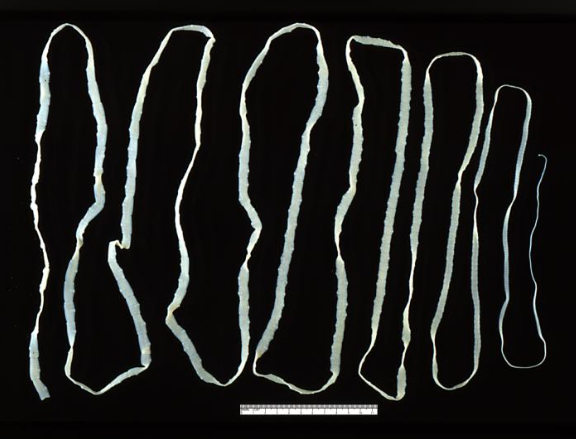Teniosis; intestinal parasites. ''Solitary''.
When they are adults, the human is their definitive host, which means that, they reproduce and spend their entire adult life, living in the digestive system.
In the larva stage, they can be found in men or in parasites, playing a role as intermediate hosts, that is, where they mature, locating in different tissues.

Within this class, cestodes or segmented worms we can find:
• Taenia solium (Found in the pig).
• Taenia saginata (Found in the cow).
• Hymenolepis nana.
• Hymenolepis diminuta.
How are these worms?
They are conformed by a head or scolex in which they present suckers, which adhere to the intestinal mucosa, where they are fed by sucking thanks to the nutrients in the man's blood. Next, they have a short and narrow neck, from which the proglottids (segments) are formed.

These segments are divided into young, mature and old, this last ones being those at the end of the worm (at the end of the tail) which are the next ones to be detached.
How do we get infected?
Through feces, both old proglottids and eggs are eliminated. If these fall into animal feed (cows and pigs), they become contaminated and the eggs hatch forming larvae or cysticerci.
And then, once we consume the larva of the parasite, it evolves until it becomes an adult and the cycle is repeated.
Two things can happen, that the larva evolve into an adult or that the larva migrates to another part of the human body as to the brain and then we talk about another disease, cysticercosis. But this happens when it comes to the cysticercus from the Taenia solium (pig).

What is its symptomatology?
• You can see the proglottids in the excrement, which are light colored and move.
• Discomfort when defecating.
• Mild abdominal pain.
• Appetite alteration.
•Weakness.
•Weightloss.
• Nausea.
How is it diagnosed?
Due to the presence of proglottids in the excrement or in the perianal region.
What is the treatment?
A single dose of praziquantel (10 mg / kg).
For more information, see your trusted doctor. Avoid self-medication.
@mariaagarcia
If you liked this article, give it to resteem, so the information will be irrigated and it will reach more people.
Bibliography:
Harrison Principios de Medicina Interna 18a Edición.
Images:
Google images '' Labeled for reuse ''. Source: Wikimedia Commons.